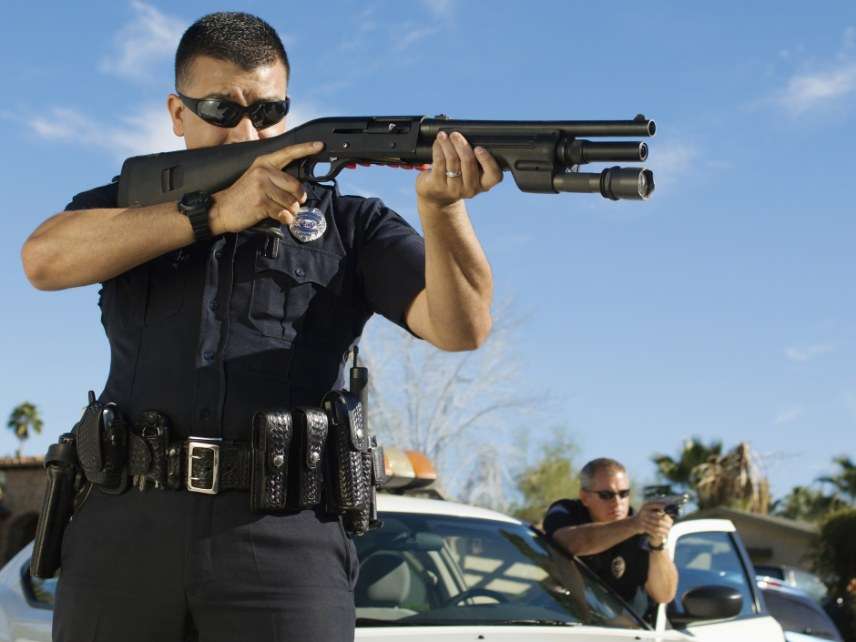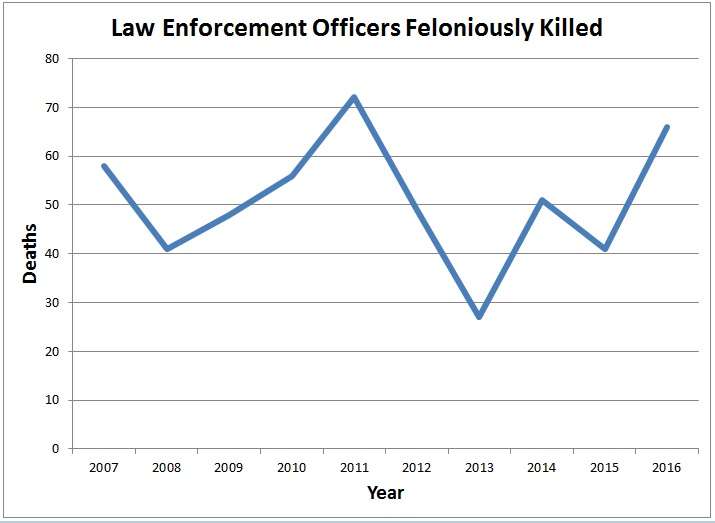Police Deaths Up for 2016, but Are Already Trending Back Down
An increase in ambush deaths feeds a "war on cops" narrative, but the numbers remain small.

The number of police either assaulted or killed in the line of duty increased significantly from 2015 to 2016. Does that mean the "war on cops" is real? Not if you take a closer look at the numbers.
This week the FBI released its annual report on Law Enforcement Officers Killed or Assaulted. For 2016, 118 police officers were killed in the line of duty. In 66 cases, these deaths were the result of felonious acts. In 2015, only 41 officers were killed by attacks.
An increase of 25 people does not sound large. But if you present it as a percentage increase, it looks huge: 62 percent. And so Attorney General Jeff Sessions, joining President Donald Trump in arguing that there's a war on police officers, went right to that percentage, calling it "staggering" in a prepared statement.
Changes in small numbers always look huge when presented as percentages. I noted this previously when talking about crime statistics more broadly. And these are indeed small numbers. There are more than 700,000 sworn law enforcement officers in the United States. People who work in construction or transportation fields are more likely to die on the job. Needless to say, that doesn't mean that we should ignore assaults on cops. But you need to see some context before you start considering solutions.
Here's some more context—a chart showing the numbers of police killed by attacks since 2007:

2016 also saw some high-profile ambushes of police in Texas and Louisiana. The FBI reports that 17 officer deaths in 2016 were the result of "ambush" attacks. Only four officers were killed in 2015 in ambushes, according to the FBI.
That spike in ambush attacks could be seen as explaining a good chunk of the increase between the two years; it also helps explain the "war on cops" narrative. But that chart should serve as a warning against treating those ambushes as a trend. According to the Officer Down Memorial Page, which tracks police deaths as they happen, the number of police killed this year—both from attacks and from accidents—is going back down. So far in 2017, 38 officers have been killed by guns and two by vehicular assault. At this point last year, 47 cops had been killed by guns. The numbers for 2016 are higher than usual, but right now they look more like statistical noise than an ongoing trend.
The reason it's important not to jump to join the "war on cops" narrative is because law enforcement lobbies and the Trump administration have been pushing the idea that we may need new legislation bring that alleged war to an end. That has led to "Blue Lives Matters" laws, which expand hate crimes sentence enhancements to people who target police officers or emergency responders. Laws like this have been passed in Louisiana and Kentucky, and they are already being misused to treat any sort of resistance or misbehavior directed toward the police—not just ambushes and cop-killings—as a "hate crime."
One of Trump's first executive orders when he took office was to call for action to curtail violence against police officers, and it's obvious that this one-year spike in deaths and assaults will be used to justify ramped up punishments, even though there's no evidence more punishment is necessary or will accomplish anything. It's not like people who assault or kill police officers get slaps on the wrists.
Exhaustive data about deaths and assaults on police may be found here. Note how much more extensive this data is than the incomplete and woefully undercounted federal figures documenting when police kill others.


Show Comments (8)